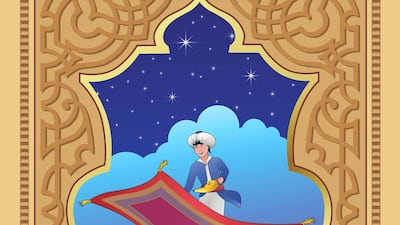You probably don’t need an introduction to the One Thousand and One Nights. The timeless tales told by Scheherazade to the ruler Shahryar are well known not only in the Middle East, but around the world.
But now, Richard Van Leeuwen, a senior lecturer in Islamic Studies at the University of Amsterdam, says the influence of the many stories is more far-reaching than previously thought.
In his 2018 book, The Thousand and One Nights and Twentieth-Century Fiction: Intertextual Readings – which last month won the Sheikh Zayed Book Award for Arabic Culture in Other Languages – the Dutch author explores how the collection of Middle Eastern folk tales have had a decisive influence on the shaping of world literature over the past century.
“Authors looking for new narrative forms and techniques often took the Thousand and One Nights as a kind of primeval model of storytelling, as a source of inspiration,” he tells The National.

So what was it about the collection that captured the imagination of 20th-century writers such as Marcel Proust and Toni Morrison?
For a start, says Van Leeuwen in his book, writers such as French author Michel Butor and German author Hugo von Hofmannsthal seemed to have been particularly inspired by the stories' locations.
In One Thousand and One Nights, many of the stories contrast closed spaces (such as castles and crypts) with journeys through wide, unstructured spaces, such as seas and enchanted worlds. The destinations juxtapose theories of stagnation and mobility, usually denoting a hero's call to adventure outside of their comfort zone.
The narrator of Butor’s 1967 novel Portrait of the Artist as a Young Monkey, for example, retires to a castle in Germany for a week. His confinement is paralleled and contrasted in the story of the Second Qalander, in which the prince is transformed into a monkey and sets out to roam the world.
Similarly, Hofmannsthal, in his 1895 novel The Tale of the 672nd Night, writes about the son of a merchant who lives in isolation and who is suddenly forced to leave his self-sufficient home only to enter a strange, enchanted outside world, which exposes him to an unexpected death.
Another characteristic of One Thousand and One Nights that lent itself to inspiration, says Van Leeuwen, was its frame-story – the overarching theme that bound the tales within the collection.
The frame-story tells of Shahryar’s rage after he becomes aware of his wife’s infidelity and executes her.
The furious king then decides that all women are guilty and deserve to be executed, proceeding to marry one young woman every evening and executing her in the morning.
This continues until he takes Scheherazade as his bride and she begins to tell her famous stories, stopping at cliff hangers so she would survive to the next day.
Vladimir Nabokov's 1938 Invitation to a Beheading, too, used this connection between storytelling and survival.

“Here, a prisoner tells his life story while he is waiting for his execution. In the story some strange incidents are inserted, which suggest that the story has ‘absorbed’ the narrator and that his life depends on his continuing his story,” Van Leeuwen says.
A number of 20th-century authors also relied on the narrative devices of One Thousand and One Nights to emphasise the tension between real events and how they were represented in text.
A group of works that highlight this is William Faulkner’s Absalom, Absalom! (1936), Toni Morrison’s Beloved (1987) and Andre Brink’s Imaginings of Sand (1996).
“All three novels investigate the connections between history, memory, and storytelling, and show how historical narratives are rooted in collective human experiences,” Van Leeuwen says. “All three novels are centred around a mysterious house that is possibly enchanted, representing an alien element in its environment and fostering the deconstruction of dominant historical discourses to give space to alternative visions of the past.”
Van Leeuwen says that novels that fall under the magical realism genre also tend to fall in this category. These include Gabriel Garcia Marquez's One Hundred Years of Solitude (1967) and Salman Rushdie's Midnight's Children (1981) and Shame (1983), which "at the time, were considered to subvert the hegemonic discourses of literature and neo-colonial politics in the West."
Van Leeuwen’s book shows that the influence of One Thousand and One Nights was structural, systematic and crucial for the development of modern literature and that this influence was derived from the strength of the work as a literary text, rather than from Orientalist tastes, cultural appropriation, exoticism or ideological interests.
“It reevaluates the significance of the collection, and thereby the influence of Arabic literature and culture, in the formation of modern culture,” he explains.
Van Leeuwen says receiving the Sheikh Zayed Book Award was a great honour, especially because it shows that his work is appreciated by his colleagues in the Middle East.
“Because the book is about cultural and literary exchange, this is very important to me," he says.
"I hope the award will contribute to a wider distribution of the book in the Arab world and among Arabic intellectuals, because, I think, it provides new insights in the processes of cultural interaction.”


